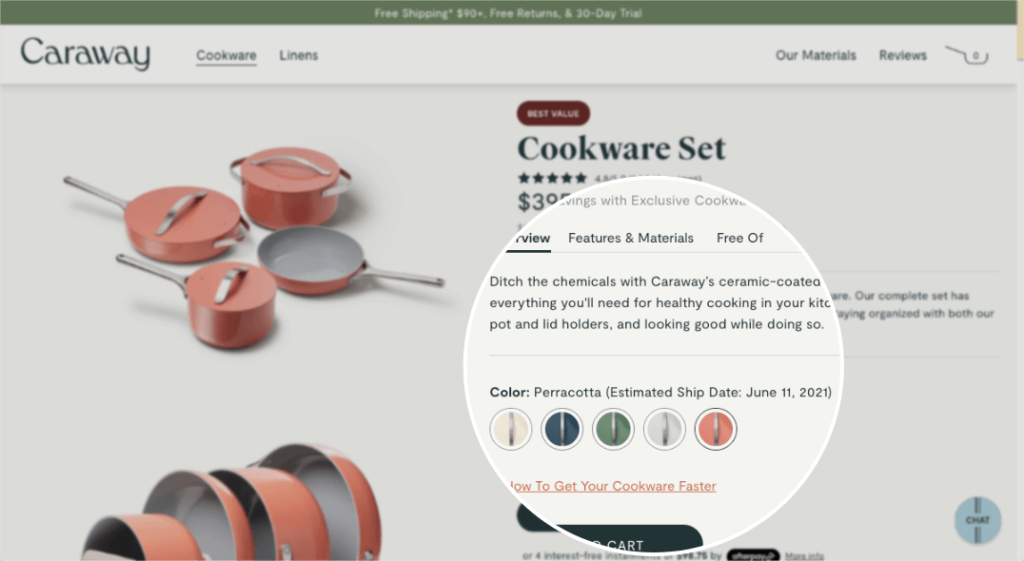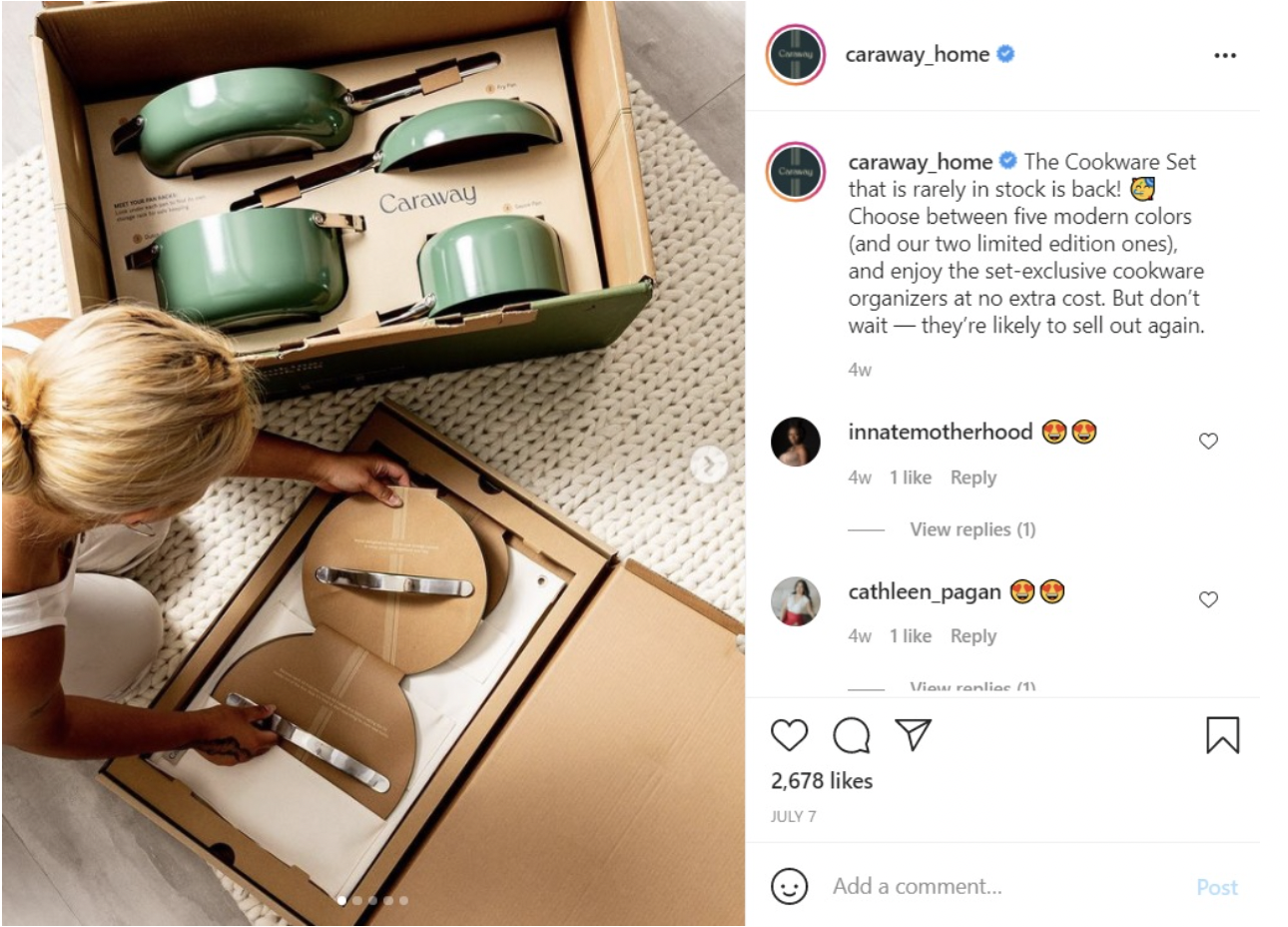- Blog
- Cogsy news
- Supply chain
How Caraway Unlocks New Growth With Cogsy


It’s an exciting time to be operating in the DTC space. Tech-savvy companies have revolutionized retail and raised customers’ expectations for a seamless shopping experience.
However, since the pandemic outbreak, everyone has been facing supply chain issues. Almost 65% of retailers worldwide adapted their supply chain for ecommerce as a result of the COVID-19 pandemic. And 28% of them reported dealing with shortages and out-of-stock items.
Businesses are turning to pre-order and backorder models to continue selling and generating revenue. And as a result, they’re ensuring business continuity. However, the tricky part is figuring out how to stay on top of inventory management to fuel business growth.
To understand the common challenges of this model and the role of inventory management in overcoming supply chain issues, we talked with Mark Riskowitz, Head of Operations at Caraway.
Caraway, the DTC cookware brand, was launched in November 2019 after its founder, Jordan Nathan, searched (without success) for non-PTFE or Teflon-coated products. Frustrated at the lack of options, he set out to create his own.
Today, Caraway’s four-piece, non-toxic, non-stick set of ceramic pots and pans with a playful color palette are the product of that initial frustration.
The products’ modern design and aesthetics made them instantly popular. And the company raised $5.3M in seed funding to support the fast-paced growth the company experienced right from the start.
Unlike many other DTC brands, Caraway tested the waters with wholesale early by selling its products through a handful of other websites, including Bloomingdales, West Elm, and Target.
Aside from this, they have an exclusive partnership with Crate and Barrel for their best-selling four-piece set, but in an exclusive color — silt green with gold handles.
The COVID-fueled demand for home goods kept Caraway’s strong momentum going long after its initial launch.
But it also presented a challenge: the havoc the pandemic and other world events created around the global supply chain left orders delays.
So, Caraway had to find a better solution to inventory management to meet customers’ expectations.
The pandemic-imposed lockdowns caused a significant customer behavior shift. Suddenly, online shopping became the norm rather than the exception. In fact, according to DigitalCommerce360, online retail sales increased 32.4% year over year in 2020.
Some industries were fortunate to experience sky-high demand. Salesforce data from 2020 showed an unprecedented 51% YoY increase within the home goods space.
Over a year later, the cookware market is still poised to grow by $5.30B between 2021 and 2025, progressing at a compound annual growth rate (CAGR) of almost 4% during that period.
Working from home, closed restaurants, and spending more time at home, in general, made consumers take a hard look at their home cooking equipment. For some, this spurred a desire to replace old, chipped pots and pans with new, high-quality, attractive-looking substitutes.
Caraway was there to meet this desire.
 Source:
Caraway
Source:
Caraway
This wasn’t all great news, however. With the increased customer demand paired with pandemic-related limitations, the global supply chain went off the rails.
From overwhelmed factories to clogged ports, thousands of companies hit a brick wall when it came to meeting that increased demand. And roughly 87% of consumers encountered out-of-stock products during the first months of the pandemic.
Caraway’s products, for example, are manufactured in China. They have contracts with manufacturers and vendors that produce all materials and then assemble and pack their goods overseas. From there, they import them into the U.S. However, the global supply chain situation meant Caraway also faced delayed turnaround times.
So, how could they capitalize on the purchase intent despite the increased order lead times due to supply chain troubles?
“"We've been very fortunate during COVID when home cooking became more relevant than ever before. That was certainly a catalyst to the growth that we saw in the accelerated demand (which exceeded our expectations). But it also created this chasing game wherein we attempted to bring supply up to the demand we were seeing."
Caraway decided to implement a backorder model to get them the necessary working capital for inventory and growth initiatives.
However, to rely on the backorder model, they needed an inventory management infrastructure that would take on this heavy lifting.
One of the biggest pain points for Caraway was the manual update of countless spreadsheets containing data about available inventory, products that need to be reordered, and general forecasting.
As a result, their data would quickly become outdated. And by the time they learned about an issue, too much time had passed.
Many DTC retailers have experienced similar roadblocks.
For example, suppose one of your SKUs is selling out faster than expected. In this case, the lack of timely inventory updates could cause severe problems and leave customers frustrated. At the same time, they wait for their orders much longer than anticipated.
Deploying a backorder model means customers can order your products before they’re ready to ship. And it leverages scarcity, where the fear of missing out (FOMO) urges customers to make the purchase before the next batch sells out.
Tapping into FOMO is a smart sales strategy. Especially considering 60% of Millennials said they make a reactive purchase after experiencing FOMO… most often within 24 hours of first feeling it.
 Source:
Caraway
Source:
Caraway
In Caraway’s case, the backorder model made sense. That’s because customers felt the premium quality, non-toxic materials, and exceptional design made the four-piece cookware set one worth waiting for.
But to pull it off, the team at Caraway needed an inventory management solution that could support the backorder model. And the team needed to be both transparent and proactive when communicating with customers patiently waiting for their orders to ship.
To stay on top of the supply chain havoc and support its new backorder model, Caraway needed to eliminate manual forecasting while selling effectively on backorder. To do this, they partnered with Cogsy, an inventory optimization tool for growth-focused ecommerce brands.
Cogsy helped Caraway monitor and accurately forecast its inventory and communicate with customers about when to expect products to ship. Armed with this information, the cookware brand set proper expectations around delivery dates. All while removing uncertainty and encouraging customers to purchase before products were restocked.
“"By providing the infrastructure for a seamless customer journey while being over-communicative about what that means, we've been able to leverage the momentum and convert customers at the moment they show interest in our product."
As a result, Caraway kept selling items on backorder and had the data to keep all stakeholders in the loop. In other words, Cogsy helped Caraway:
““Cogsy allows us to have an exact understanding and visualization of what is going on in terms of product availability. What to expect, what the various upcoming batches look like, as well as the timelines of incoming products. Leveraging that information helps the team with data-driven internal and external planning to capitalize on all opportunities.”
With Cogsy, Caraway leverages the power of data to make informed decisions and pave way for future business growth.
Key highlights since partnering with Cogsy include:
One of the most significant benefits for Caraway was the free working capital that was secured by collecting up-front payments from orders that were yet to be delivered. This could then be used to further invest in the brand’s growth.
The result? Caraway completely flipped their cash conversion cycle.
““Having a platform to log into where within five minutes I can have a full understanding where the product is, how much to reorder, when orders are arriving, and what our forecasted sales look like based on previous data cuts down the time we would spend doing this work manually by about 90%.”
The global supply chain shock caused by the pandemic upended formerly predictable operations. Companies have found themselves in uncharted territories that require agile and timely inventory management to keep businesses up and running.
The backorder model is not suitable for all products (specifically, widely available ones, like dish soap and paper towels, for example). But it was a great solution for Caraway’s highly-valued premium products because customers were willing to wait for.
“"Customer behavior has changed and adapted to be more lenient and flexible about lengthy ship dates or lead times."
 Source:
@caraway
Source:
@caraway
Allowing customers to order a product even if it’s currently out of stock gives the businesses more capital thanks to up-front payments.
However, DTC businesses need to be well equipped to effectively apply this strategy. Here are a few key aspects that companies have to understand about the process to prevent customer disappointment:
Everything Caraway implemented around inventory management comes back to creating a seamless customer experience. Caraway makes sure customers have a top-notch end-to-end journey. This includes everything from offering the highest quality cookware sets and a seamless shopping experience to smart inventory management and transparent communication.
Understanding the solutions, they needed to support this level of customer excellence helped them build the business on a solid foundation. And it also ensures consistent customer experiences as the company grows.
In the next three to five years, the backorder model could become a regular practice, allowing companies to tap into scarcity and FOMO. Not to mention it will likely change the entire DTC landscape.
Regardless of if you’re testing waters with a backorder model or you just need real-time inventory updates, one thing is for sure: you need an inventory management solution to fuel business growth.